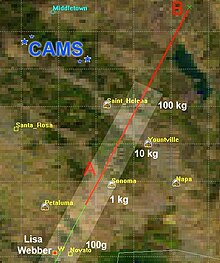astro.wikisort.org - Meteorite
The Novato meteorite is an ordinary chondrite which entered the earth's atmosphere and broke up over Northern California at 19:44 Pacific Time on 17 October 2012. The falling bolide created a bright fireball and sonic booms and fragmented into smaller pieces as the intense friction of passing through the atmosphere heated it and absorbed its kinetic energy.[2] The meteoroid was about 35 centimeters (14 in) across.[3]
| Novato meteorite | |
|---|---|
 Peter Jenniskens meteor trajectory. Six fragments have been found in Novato, California. More massive 1 kilogram (2.2 lb) fragments may have fallen near Sonoma with any 10 kilograms (22 lb) fragments possibly falling near Yountville / St. Helena. This trajectory estimate may be inaccurate. | |
| Type | Chondrite |
| Class | Ordinary chondrite |
| Group | L6 |
| Shock stage | S4 |
| Weathering grade | W0/1 |
| Country | USA |
| Region | California |
| Coordinates | 38.1°N 122.6°W[1] |
| Observed fall | Yes |
| Fall date | 17 October 2012 |
| Found date | 20 October 2012 |
| TKW | ~363 grams (6 recovered)[1] |
| Strewn field | Yes |
| Alternative names | Mill Valley |
Meteorite
The first fragment of the meteorite (N01) was recovered by Lisa Webber on 20 October after reading a story in the San Francisco Chronicle that described the NASA/CAMS meteor trajectory predicting a fall area in the North Bay.[4] Lisa recalled hearing a sound on her roof the night of the meteor and went outside and located a 62 gram stone. Analysis of fragment N01 by Dr. Alan Rubin came back as a L6 breccia.[5]
The second fragment was found by Brien Cook on 22 October (66 grams) and the third fragment was found by Jason Utas on 27 October (79 grams).[1][6] The largest fragment recovered as of 5 November 2012 is N04 at 96 grams found by Robert Verish on 27 October.[7] A fifth stone (N05) weighing 24 grams was found by Jason Utas on November 2.[6] A sixth stone (N06) weighing 23.7 grams was found by the Kane family on November 11.[7] More massive 1 kilogram (2.2 lb) fragments may have fallen near Sonoma with any 10 kilograms (22 lb) fragments possibly falling near Yountville.[8]
This was the second significant meteorite in California in 2012, the first being the Sutter's Mill meteorite.
See also
- Glossary of meteoritics
References
- Peter Jenniskens. "The Impact and Recovery of the Novato Meteorite". SETI Institute. Retrieved 2012-11-02.
- Mike Hankey. "Massive Fireball Over California Coast – October 17th, 2012". American Meteor Society. Retrieved 2012-11-02.
- Elizabeth Howell (2014-08-19). "Roof-Crashing Meteorite Linked to Giant Impact that Made the Moon". Space.com. Retrieved 2014-08-21.
- Clara Moskowitz (2012-10-22). "Meteorite from Recent Fireball Hit Roof of N. California Home". Scientific American. Retrieved 2012-11-02.
- Buseman, H.; Clay, P.L.; Jenniskens, P.; Meier, M.M.M.; Wieler, R. (2013). "Noble Gases in the Light and Dark Phase of a Meteorite Found in Novato, California". MAPS. 76: 5213. Bibcode:2013M&PSA..76.5213B. 76th Annual Meteoritical Society Meeting (2013). Retrieved on 2013-12-01.
- Jason Utas (4 September 1950). "Expedition: Novato, California". Retrieved 2013-12-01.
- Bob Verish. "Findings from the Strewn-field". Retrieved 2013-01-05.
- Peter Jenniskens. "CAMS". SETI Institute. Retrieved 2012-11-02.
External links
- Bay Area Fireball, Oct. 17, 2012 (Animation of Robert P. Moreno Jr images)
- Bob Moreno images of meteor just outside Santa Rosa (ABC 17 Oct 2012)
- CAMS News blog (CAMS is an automated video surveillance of the night sky in search of meteors to validate minor showers in the IAU Working List of Meteor Showers)
- Meteorite Hunt (Jason Utas)
- Findings from the Strewn-field (Bob Verish)
Другой контент может иметь иную лицензию. Перед использованием материалов сайта WikiSort.org внимательно изучите правила лицензирования конкретных элементов наполнения сайта.
WikiSort.org - проект по пересортировке и дополнению контента Википедии


